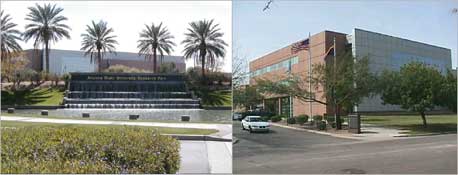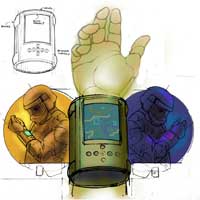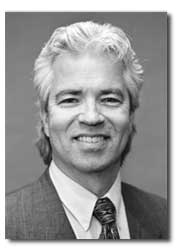February 10, 2004
The U.S. Army has awarded Arizona State University
a $43.7 million, five-year cooperative agreement to establish the
Army Flexible Display Center, where flexible, low-power computer
displays will be developed that can be continually refreshed with
new data and carried in the field – a device that will revolutionize
combat strategy.
“Think of these displays as thin computer screens that can
be rolled up or folded and put in a warfighter’s pocket,” said
Greg Raupp, ASU professor of chemical engineering, Associate Vice
President for Research, and director of the center. “The
displays would be integrated with wireless communications technology
linked to central command and control, enabling continual updating
of information vital to a successful operation.”
For example, these real-time displays will provide improved operational
communications by supplying information on troop and enemy positions
and movements, weather and environmental conditions, and other
important variables providing dynamic field intelligence.
This $43.7 million agreement has a performance period of five
years with an option for an additional $50 million over an added
five-year period.
“This award is further evidence that ASU can compete with
the nation’s elite institutions for awards of this magnitude
and importance on an international scale,” said ASU President
Michael Crow. “There is keen interest in our capability to
develop advanced technologies, integrate those technologies together
into working devices and deploy them in the most critical and demanding
applications. It has enabled us to compete successfully to get
this center against very stiff competition and a rigorous review
process.”
Display technology is critical to the Army’s network centric
Future Force.
“Flexible display technology has the potential to be implemented
in a wide variety of applications from command centers, to vehicle
platforms, to individual soldiers. It will revolutionize the way
in which information is disseminated on the battlefield, increasing
both the lethality and survivability of the Future Force,” said
Acting Director U.S. Army Research Laboratory, John Miller.
The award is testament to ASU’s ability to attract vital
resources to the university and advance high tech growth in the
Valley. The reputation of the Arizona Biodesign Institute (AzBio),
where most of the science for the flexible display initiative will
be conducted, is key in winning such path-breaking proposals.
The director of AzBio, world-renowned scientist George Poste,
said passage last year of the Research Infrastructure Bill, which
allocated $450 million to the state universities for the construction
of world-class research infrastructure facilities, was an essential
element in ASU’s success.
Also key in winning the award was the creation of the Applied
NanoBioscience center in the Arizona Biodesign Institute, with
outstanding scientists, engineers, and donated equipment and facilities
from Motorola.
“The Army’s Flexible Display Center will integrate
the best research being done in the government, universities, and
industry to rapidly bring to the soldier the full potential of
flexible display technology”, said Acting Deputy Assistant
Secretary Research and Technology, Dr. Thomas H. Killion. “This
paradigm shifting technology will make obsolete printed matter
and the printing press.”
This center is a major undertaking by the U.S. Army that is being
launched after an intense, nearly year-long national competition.
During a site visit in September, representatives from the Army
toured ASU’s proposed location for the center, a state-of-the-art
multi-functional display manufacturing R&D facility in the
ASU Research Park. This signature 250,000 square foot facility
was originally a Motorola facility designed for flat panel display
R&D. It includes 43,500 square feet of advanced clean room
space and extensive wet and dry labs. ASU’s option to acquire
the facility will allow a very rapid start up for the project,
a scenario the Army deemed important to the success of the project.
 FDI Center facility in ASU Research Park
FDI Center facility in ASU Research Park
“ASU’s success in winning
this award is the result of a well-thought-out, strategic and coordinated
effort,” said Jonathan Fink, Vice President for Research
and Economic Affairs. “It is proof our new style of rapid,
focused competition, including making major investments and commitments
up front, positions us to triumph over more mature competing institutions.
“An incredible amount of work went into obtaining this award
and it has been inspiring to witness the teamwork, collaboration
and extra effort that have gone into the process,” said Fink. “I’m
extremely proud, and I want to commend the entire ASU collaboration
team and our industry partners for their leadership and tireless
commitment throughout this effort.”
Raupp said within the first year, the center will have a fully
operational 6-inch thin-film transistor (TFT) and organic light
emitting diode (OLED) pilot line, a state-of-the-art OLED R&D
laboratory, and a supporting 4-inch TFT R&D toolset. Transition
to larger display size will occur within a few years as a so-called
GEN II pilot line processing 370 mm x 470 mm substrates will become
operational.
The ASU Army Flexible Display Center is a university-industry-government
collaboration that will provide a national asset in flexible display
technology research, development and prototype manufacturing.
“The center will be the focal point in a large-scale national
effort to provide tomorrow’s warfighters with ubiquitous,
conformal and flexible displays that are lightweight, rugged, low
power and low cost,” Raupp said. “These displays will
be integrated with computation, communications and global positioning
subsystems to significantly enhance the soldier’s situational
awareness, survivability and effectiveness.”
Working within the center will be researchers from a strategically
formed team of military, industry and academic partners. Industry
partners include DuPont Displays, Kodak, Honeywell, General Dynamics,
Raytheon, Universal Display Corporation, Kent Displays, E Ink,
FlexICs, Three-Five Systems, General Atomics, Optiva, ECD, Southwall,
the U.S. Display Consortium, and AGI. Key academic partners include
Cornell University, the University of Southern California, Penn
State University, University of Arkansas, and the University of
Arizona Optical Sciences Center.
“The outstanding capabilities of our facility and its manufacturing
R&D infrastructure will enable us to work side-by-side with
our partners to intensively co-develop new breakthrough technologies,” noted
Raupp.
In addition to purchasing the Motorola facility, ASU is in midst
of a rapid expansion of its research infrastructure, with facilities
already purchased, under construction, and planned, which will
add 1 million sq. ft. of world-class research space. The state
of Arizona, with passage of the research infrastructure bill last
June, has committed $185 million to ASU for research facilities
that will attract top scientists and additional revenue, as well
as spawn new business and industry in Arizona.
As part of the flexible display initiative, a suite of candidate
display technologies will be developed and fully evaluated. Select
technologies will be integrated into working prototypes and demonstrators
for controlled field testing by the Army and partner companies.
Learning gained through the prototyping activities will feed back
into the research program to drive further advances in display
size, capability and performance.
In addition to military uses, flexible display technology promises
to provide a boost to U.S. display companies by helping to create
many significant future commercial applications. Raupp said the
center will seek creative opportunities to leverage intellectual,
physical and technological capability to establish one or more “product
cooperatives” that could substantially accelerate technology
advancement and market readiness, enhance prototyping and manufacturing
capability and strengthen the overall domestic flexible display
industry.
Media contact:
Skip Derra, (480) 965-4823; skip.derra@asu.edu |

Conceptual first integrated
conformal display system

Greg Raupp

Six displays on a GEN II substrate
(photograph courtesy of
Motorola, Inc.)
|